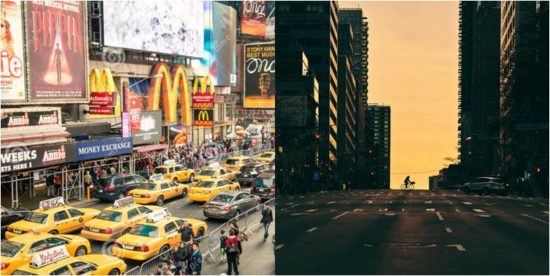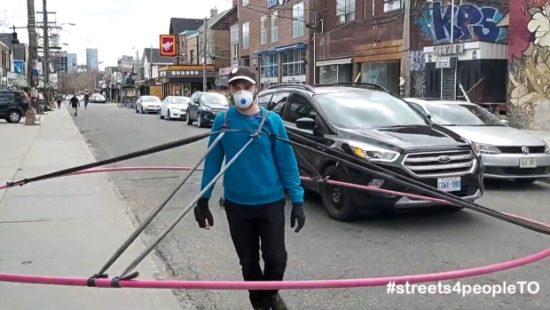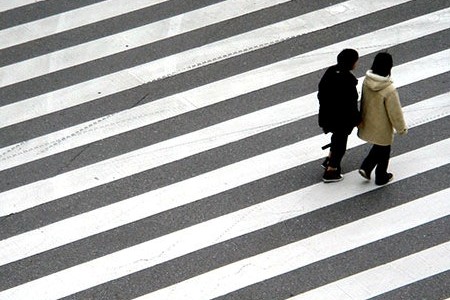April 21, 2020 – The media has been posting pictures lately of downtowns and landmarks of the world’s cities and the images are making us realize that urban spaces without lots of vehicle traffic can be both haunting and beautiful. Although some urban dwellers feel cities are meant to be what you see in the picture below to the left, all hustle and bustle, others can only imagine city living as depicted on the right, an urban oasis with less noise, less pollution, and a better quality of life.

Here in Toronto where we have experimented in the past with pedestrian and bicycle-only rights-of-way on urban streets, the pandemic has city councillors and our mayor speculating on whether with social distancing we need to widen pedestrian access to include part of the pavement where cars, trucks and buses have predominated. The two-meter (six-feet) social distancing rule that cities have enacted has made urban planners realize that most sidewalks are unsuitable as pedestrian paths during a pandemic. To illustrate just how inappropriate, one Toronto resident has created his own social distancing machine (see image below) to demonstrate what the two-meter rule means. Current pedestrian-designed sidewalks in Toronto, for the most part, cannot accommodate the prescribed separation. So it looks like the right time to build a network of pedestrian-only and protected bicycle rights-of-way here in my home and in other cities dealing with the pandemic, the stay-at-home strategy, and social distancing requirements.

In Europe, Milan, Italy, where the COVID-19 virus struck with impunity, has seen traffic drop by as much as 75%. Air quality has dramatically improved making city streets far more appealing to walkers and cyclists. Milan’s city council has decided to transform 35 kilometers of its downtown to make it pedestrian and cycle-friendly beginning this summer and continuing once the pandemic restrictions get lifted. Marco Granelli, Deputy Mayor of Milan, in an interview with The Guardian this week, talked about how the city has been trying for years to reduce urban car use because of congestion and pollution. And now because the pandemic has shown the city officials a different Milan, Granelli believes it is time to make a transition to make the small shops in the downtown far more accessible to pedestrians and cyclists. He stated, “We think we have to reimagine Milan in the new situation. We have to get ready; that’s why it’s so important to defend even a part of the economy, to support bars, artisans and restaurants. When it is over, the cities that still have this kind of economy will have an advantage, and Milan wants to be in that category.”
Will other cities follow suit? Some see this new agenda as being a war against the car. But the pandemic is equally incompatible with mass transit because of the need for social distancing. Being locked down in homes in cities where so many live in small spaces (apartments and condominiums), means there needs to be outdoor space for people to walk, cycle, and exercise. Urban dwellers in high-rise building don’t have backyards. At most they have a terrace or small balcony which means the need for street space becomes critical. And now because of COVID-19 and the trend to work from home, road capacity requirements have been diminished because far fewer are commuting to offices and jobs.
The end results are starting to show in many places across the globe. New York City has seen a surge in cycling with people avoiding mass transit because of social distancing and a fear of getting infected. The city plans include new bike lanes on major routes in Manhattan and Brooklyn. London is condoning off some of its downtown streets to become pedestrian-only. Dublin is placing restrictions on vehicle traffic and parking in its downtown core. Besides New York City, Washington, DC is creating pedestrian-only streets as is Seattle. Mexico City is quadrupling its cycling network. Bogota, Colombia is adding 75 kilometers (47 miles) of bicycle lanes in its downtown core. And Montreal, like Toronto, is adding more pedestrian and cycle-friendly roads to reduce or eliminate vehicular traffic.
It appears that urban planners who saw more pedestrian and cycle-friendly cities as something a decade ahead have seen their plans for more livable cities kickstarted by a tiny virus a good decade ahead of what futurists had predicted.









